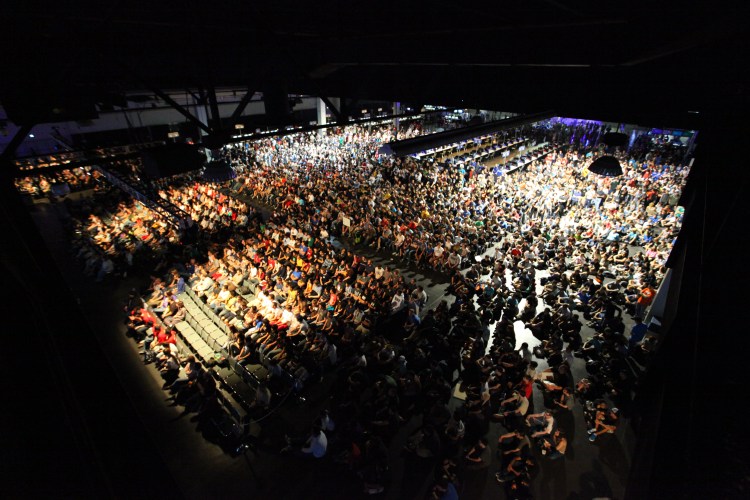Esports is having its ESPN-moment, which means abundant opportunities are within reach to drive the collective experience forward. Who wants the ball?
In 1979, the sports broadcasting upstart Entertainment and Sports Programming Network, now commonly known as ESPN, aired its first edition of its nightly news and highlights show, SportsCenter: “From this very desk,” host George Grande proclaimed, “we’ll be filling you in on the pulse of sporting activity not only around the county, but around the world as well.” It was the first proclamation of a major shift in the coverage of sports. Rather than being content with coverage of their local teams and analysis from familiar beat writers, fans would be able to access alternate opinions and live updates on games outside of their zip code. Unlike their print brethren, for the first time, fans could follow a sport on TV as well as a team.
Esports has become a global phenomenon in the last 15 years, gathering momentum with the advent of livestreaming — and it’s no surprise that this new industry is learning lessons from ESPN’s trailblazing. Whether they’re watching a stream from the Korean Pro League or reading deep tactical analysis of picks and bans for an upcoming tournament, esports fans want access to just as much content as football fanatics or baseball sabermetricians-in-training. As the industry continues to mature, its top personalities and contributors are looking to deliver the same depth of insight to the sport’s worldwide audiences that ESPN did for “traditional” sports fans in ‘79.
And they’re facing the same challenges that ESPN did in ’79.
Esports is already big. What more does it need?
According to a report that market research firm SuperData issued this month, esports now reaches a worldwide audience of 134 million people and drives over $600 million in annual revenue. Despite this explosive growth, the technology and business practices available to the esports fan community have lagged behind the industry in terms of flexibility and sophistication. The passion and expertise of the community is undeniable, but turning that into a consistently high-quality experience that can deliver contextualized data to support the needs of broadcasters, advertisers, and community requires a wholehearted technical and business commitment.
This is especially true given that the prospects for esports viewership are extremely bright. The proliferation of broadband Internet access and cheap video-capable mobile devices, PCs, and consoles worldwide promises to drive even larger audiences to the scene. On a philosophical level, esports stars are relatable and aspirational, and the sports’ casters make the action much more personal and relatable.
A confluence of events drives the esports industry: Young, technically savvy and incredibly influential eyes are consuming competitive gaming at an unprecedented rate and frequently in greater numbers than traditional sports. These fans deserve the same caliber of presentation that you can see every day on ESPN. While present solutions (like Twitch, Hitbox, or ourselves at Azubu) are striving to fill this demand, the time has come to step up our game.
The time has come to innovate.
What does this improvement entail?
For starters, global esports needs a worldwide platform, complete with the technical backend necessary to ensure a reliably high-quality experience. Ironing out the distinct technical challenges of different regions around the world requires a deep understanding of each area’s unique demands, but it’s a necessary price to pay. And it’s more than a technical challenge. Once that network is in place, you can turn your attention to the rich content that builds lifelong fans and captures interest. Contextualized stats and rankings help fans understand just how good a player is, how intense the competition is looking, or how awesome a skill shot really was. Meanwhile, the “Sportscenter of esports” remains an unexploited opportunity for current broadcasters to capitalize on.
And what about ESPN itself?
The self-declared “Worldwide Leader in Sports” certainly has the resources to develop an appropriately dedicated esports section, and diversifying their portfolio of coverage with less traditional entertainment is something they’ve done before. Hat tip to GamesBeat’s managing editor, Jason Wilson, for reminding us that ESPN’s recent foray into broadcasting esports was far from its first. The network, in fact, broadcast Magic: The Gathering tournaments over a decade ago.
While ESPN has the resources, it lacks the commitment. We are entering a new era in regards to esports broadcasting and streaming. Contemporary solutions have delivered a good experience, but the large audiences of hungry viewers want more than just a stream. All streaming platforms, like Azubu, need to commit to giving them the high quality dedicated platform in order for the scene to thrive and grow.
Ian Sharpe started his career filming sports stars and Nobel Laureates at IMG, followed by a decade in video games with Atari and EA and is uniquely positioned to understand the convergence of sports, technology, and entertainment around esports.
VentureBeat's mission is to be a digital town square for technical decision-makers to gain knowledge about transformative enterprise technology and transact. Learn More

